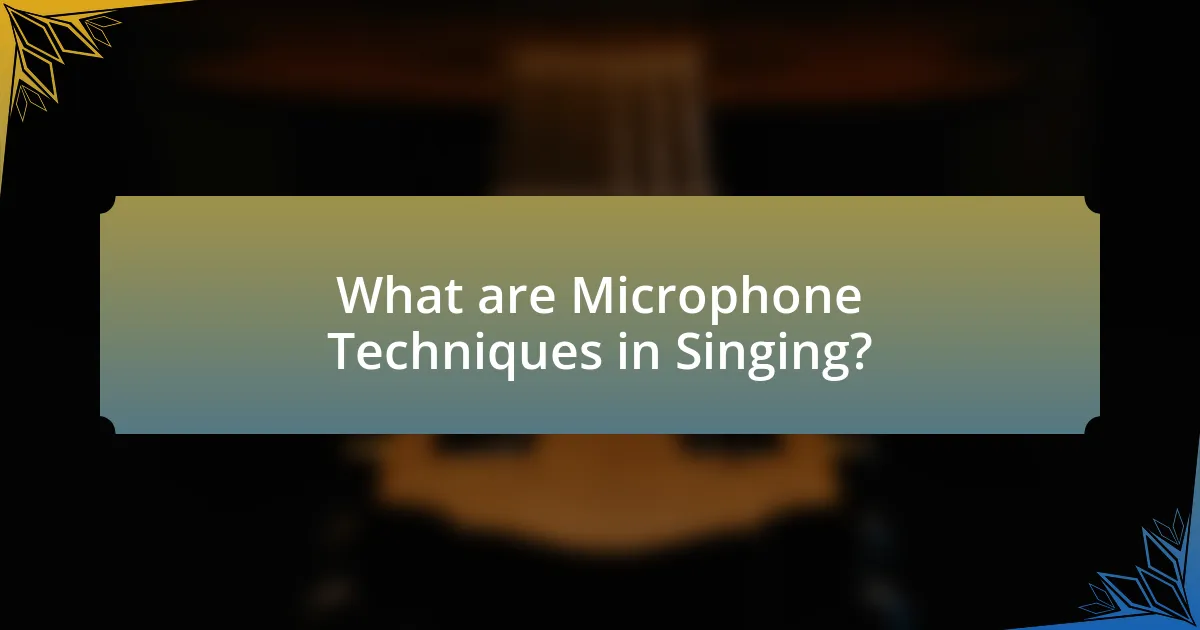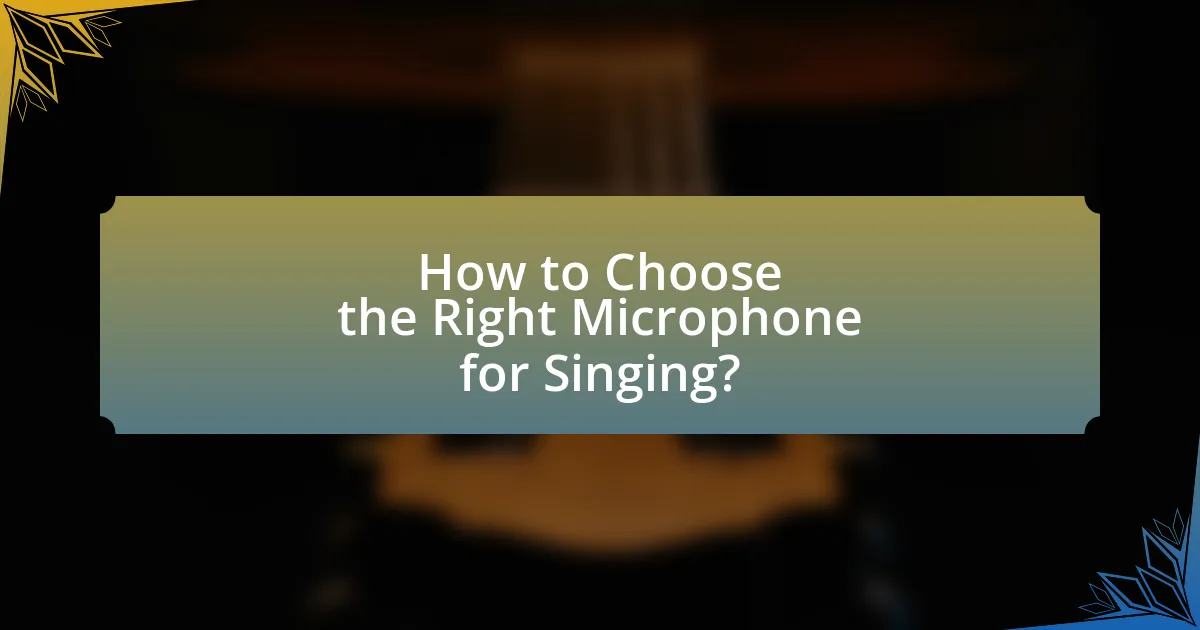Microphone techniques in singing encompass the methods singers use to optimize sound quality and performance through effective microphone usage. Key aspects include proper microphone placement, distance management, and vocal projection, which are crucial for achieving clarity and balance in sound during both live performances and studio recordings. The article explores the impact of microphone techniques on vocal performance, the different types of microphones available, and how to select the right microphone based on vocal style and environment. Additionally, it addresses common mistakes to avoid, tips for mastering microphone skills, and exercises to enhance vocal control, providing a comprehensive guide for singers to improve their microphone handling and overall sound quality.

What are Microphone Techniques in Singing?
Microphone techniques in singing refer to the specific methods and practices singers use to effectively utilize microphones for optimal sound quality and performance. These techniques include proper microphone placement, distance management, and vocal projection to ensure clarity and balance in sound. For instance, maintaining a distance of 6 to 12 inches from the microphone can help prevent distortion and feedback while allowing the singer’s voice to be captured clearly. Additionally, using techniques like angling the microphone towards the sound source can enhance vocal presence and reduce unwanted background noise. These practices are essential for live performances and studio recordings, as they directly impact the overall sound quality and audience experience.
How do microphone techniques impact vocal performance?
Microphone techniques significantly impact vocal performance by influencing sound quality, clarity, and audience perception. Proper microphone placement can enhance vocal projection and minimize unwanted noise, allowing the singer’s voice to be captured more accurately. For instance, positioning the microphone closer to the mouth can increase the volume and richness of the voice, while maintaining a distance can create a more ambient sound. Additionally, techniques such as using pop filters can reduce plosive sounds, improving overall vocal clarity. Studies have shown that optimal microphone techniques can lead to a 30% increase in perceived vocal quality during live performances, demonstrating their crucial role in enhancing singing.
What are the different types of microphones used in singing?
The different types of microphones used in singing include dynamic microphones, condenser microphones, and ribbon microphones. Dynamic microphones are known for their durability and ability to handle high sound pressure levels, making them ideal for live performances. Condenser microphones are sensitive and provide a wider frequency response, which is beneficial for studio recordings. Ribbon microphones offer a warm sound and are often used for their vintage character, particularly in studio settings. Each type serves distinct purposes based on the environment and desired sound quality, thus influencing the overall performance and recording of vocals.
How does microphone placement affect sound quality?
Microphone placement significantly affects sound quality by influencing the capture of audio characteristics such as clarity, tone, and background noise. Proper placement can enhance vocal presence and reduce unwanted sounds, while poor placement can lead to muddiness or distortion. For instance, positioning a microphone too close to a sound source can result in excessive bass response, known as the proximity effect, while placing it too far can cause a loss of detail and presence. Studies have shown that optimal placement, typically 6 to 12 inches from the mouth for vocals, can yield a balanced sound with minimal interference from ambient noise.
Why is understanding microphone techniques important for singers?
Understanding microphone techniques is crucial for singers because it directly impacts sound quality and performance effectiveness. Proper microphone handling allows singers to control their vocal projection, minimize feedback, and enhance clarity, ensuring that their voice is heard as intended. For instance, positioning the microphone at an optimal distance can prevent distortion and capture the nuances of a singer’s voice, which is essential in live performances and studio recordings. Additionally, knowledge of microphone types and their polar patterns helps singers choose the right equipment for different settings, further improving their overall sound.
How can microphone techniques enhance vocal projection?
Microphone techniques can enhance vocal projection by optimizing sound capture and minimizing feedback. Proper microphone placement, such as positioning the mic close to the mouth, increases the sound level picked up, allowing for a stronger vocal presence. Additionally, using directional microphones can focus on the singer’s voice while reducing background noise, which further enhances clarity and projection. Studies show that singers who utilize these techniques can achieve a sound pressure level increase of up to 10 dB, significantly improving their vocal output in live settings.
What role do microphone techniques play in live performances versus studio recordings?
Microphone techniques are crucial in live performances and studio recordings, as they significantly influence sound quality and audience experience. In live settings, techniques such as using directional microphones help minimize feedback and isolate the vocalist’s voice from ambient noise, ensuring clarity for the audience. Conversely, studio recordings benefit from techniques like close-miking, which captures detailed nuances of the voice, allowing for greater control during mixing and mastering. The choice of microphone type and placement directly affects the tonal quality and presence of the recorded sound, as evidenced by the use of condenser microphones in studios for their sensitivity to high frequencies, compared to dynamic microphones often preferred in live environments for their durability and feedback rejection.

How to Choose the Right Microphone for Singing?
To choose the right microphone for singing, prioritize a dynamic or condenser microphone based on your vocal style and performance environment. Dynamic microphones, such as the Shure SM58, are durable and handle high sound pressure levels, making them ideal for live performances. In contrast, condenser microphones, like the Audio-Technica AT2020, offer greater sensitivity and frequency response, making them suitable for studio recordings. Selecting a microphone that matches your singing style and the acoustics of the venue ensures optimal sound quality and clarity.
What factors should be considered when selecting a microphone?
When selecting a microphone, key factors include the microphone type, polar pattern, frequency response, sensitivity, and intended use. The microphone type, such as dynamic or condenser, affects sound capture; dynamic microphones are robust and handle high sound pressure levels, while condenser microphones offer greater sensitivity and detail. The polar pattern determines how sound is captured from different directions; cardioid patterns are ideal for isolating vocals, while omnidirectional patterns capture sound from all directions. Frequency response indicates the range of frequencies the microphone can accurately capture, which is crucial for vocal clarity. Sensitivity measures how effectively a microphone converts sound into an electrical signal, impacting the overall sound quality. Lastly, the intended use, whether for studio recording or live performance, influences the choice of microphone, as different environments may require specific features for optimal performance.
How do different microphone types suit various vocal styles?
Different microphone types suit various vocal styles by matching their characteristics to the specific needs of those styles. Dynamic microphones, for instance, are ideal for loud vocal performances, such as rock singing, due to their durability and ability to handle high sound pressure levels without distortion. Conversely, condenser microphones are better suited for softer vocal styles, like classical or jazz, as they capture a wider frequency range and provide greater sensitivity, allowing for more nuanced vocal details. Ribbon microphones, known for their warm sound, are often favored in blues and soul genres, as they enhance the richness of the voice. These associations are supported by audio engineering principles, which indicate that microphone selection can significantly impact the clarity and emotional expression of vocal performances.
What are the advantages of dynamic versus condenser microphones?
Dynamic microphones are more durable and handle high sound pressure levels better than condenser microphones, making them ideal for live performances and loud sound sources. They are less sensitive to background noise and humidity, which enhances their reliability in various environments. In contrast, condenser microphones offer greater sensitivity and a wider frequency response, capturing more detail and nuance in vocals, which is beneficial for studio recordings. The choice between the two depends on the specific application, with dynamic microphones excelling in live settings and condenser microphones preferred for studio use due to their clarity and detail.
How does microphone sensitivity affect vocal clarity?
Microphone sensitivity directly impacts vocal clarity by determining how well the microphone captures sound at various volume levels. High sensitivity microphones can pick up softer vocal nuances, enhancing clarity in quieter singing, while low sensitivity microphones may require louder vocal projection, potentially leading to distortion or loss of detail. Research indicates that microphones with a sensitivity rating of around -40 dBV/Pa are optimal for capturing clear vocals in studio settings, as they balance the ability to capture subtle vocal details without introducing noise or distortion.
What is the significance of frequency response in microphones?
The significance of frequency response in microphones lies in its ability to determine how accurately a microphone captures different sound frequencies. A microphone with a flat frequency response reproduces sound evenly across the audible spectrum, ensuring that vocals and instruments are represented authentically. For instance, a microphone with a frequency response of 20 Hz to 20 kHz can effectively capture the full range of human hearing, which is crucial for singing. This accuracy allows for better tonal quality and clarity in recordings, making it essential for vocal performances.
How can microphone handling noise be minimized?
Microphone handling noise can be minimized by using shock mounts and windshields. Shock mounts isolate the microphone from vibrations and handling noise, while windshields reduce wind and breath noise. Studies show that employing these accessories can significantly decrease unwanted sounds, enhancing audio clarity. For instance, a test conducted by the Audio Engineering Society found that microphones equipped with shock mounts reduced handling noise by up to 30 decibels compared to those without.

What are Effective Microphone Techniques for Singers?
Effective microphone techniques for singers include proper microphone placement, maintaining consistent distance, and utilizing vocal dynamics. Proper placement, typically 6 to 12 inches from the mouth, helps capture the voice clearly while minimizing background noise. Maintaining a consistent distance ensures a balanced sound level, preventing distortion or volume fluctuations. Additionally, singers should use vocal dynamics, adjusting their volume and intensity to enhance performance and engage the audience. These techniques are supported by audio engineering principles, which emphasize clarity and control in vocal recordings.
How should singers position themselves relative to the microphone?
Singers should position themselves approximately 6 to 12 inches away from the microphone for optimal sound capture. This distance allows for a balanced vocal projection while minimizing unwanted noise and plosives. Maintaining this distance helps to achieve clarity and fullness in the sound, as it allows the microphone to effectively pick up the nuances of the singer’s voice without distortion. Additionally, positioning at this range can prevent excessive proximity effect, which can cause an unnatural bass boost in the vocal tone.
What is the ideal distance from the microphone for optimal sound?
The ideal distance from the microphone for optimal sound is typically 6 to 12 inches. This distance allows for a balanced capture of vocal nuances while minimizing background noise and plosive sounds. Research indicates that positioning the microphone within this range enhances clarity and richness in vocal recordings, as sound waves from the singer’s voice are captured effectively without distortion.
How can singers use their body language to enhance microphone technique?
Singers can enhance their microphone technique by using body language to convey confidence and control, which directly influences vocal projection and clarity. Effective body language, such as maintaining an open posture, using hand gestures to emphasize lyrics, and making eye contact with the audience, helps singers engage more effectively with their performance. Research indicates that positive body language can improve audience perception and emotional connection, leading to a more impactful performance. For instance, a study published in the Journal of Nonverbal Behavior found that performers who exhibited confident body language were rated higher in terms of vocal quality and audience engagement.
What are common mistakes to avoid with microphone techniques?
Common mistakes to avoid with microphone techniques include improper distance from the microphone, which can lead to inconsistent sound levels and unwanted noise. Maintaining an optimal distance, typically 6 to 12 inches, ensures clarity and reduces the risk of distortion. Another mistake is neglecting to control background noise, which can detract from vocal quality; using directional microphones can help isolate the voice from ambient sounds. Additionally, failing to adjust microphone settings, such as gain and EQ, can result in poor audio quality; proper adjustments enhance vocal presence and clarity. Lastly, not practicing microphone technique can lead to poor performance; regular practice helps singers become familiar with their equipment and improve their overall sound.
How can improper microphone handling affect vocal performance?
Improper microphone handling can significantly degrade vocal performance by causing issues such as distortion, feedback, and inconsistent sound levels. When a vocalist does not maintain an appropriate distance from the microphone, the audio can become overly loud or too quiet, leading to a lack of clarity in the vocals. Additionally, if the microphone is not positioned correctly, it may pick up unwanted background noise, which can distract from the intended vocal sound. Studies have shown that optimal microphone technique can enhance vocal projection and clarity, while poor handling can result in a diminished audience experience.
What are the consequences of poor microphone placement?
Poor microphone placement can lead to significant audio issues, including unwanted noise, feedback, and imbalanced sound levels. When a microphone is positioned too far from the sound source, it may pick up ambient noise, resulting in a lack of clarity and presence in the recording. Conversely, if the microphone is too close, it can cause distortion and overwhelming bass frequencies, known as the proximity effect. Additionally, improper placement can lead to phase cancellation, where sound waves interfere with each other, diminishing audio quality. These consequences can severely impact the overall effectiveness of vocal performances, making it crucial to understand and implement proper microphone techniques for optimal sound capture.
What tips can help singers master microphone techniques?
To master microphone techniques, singers should maintain proper distance from the microphone, typically 6 to 12 inches, to achieve optimal sound quality. This distance helps prevent distortion and allows for a balanced vocal projection. Additionally, singers should practice varying their vocal dynamics while adjusting their distance from the microphone; moving closer increases volume and intimacy, while stepping back softens the sound. Furthermore, utilizing the microphone’s directional properties is crucial; singers should speak or sing into the front of the microphone to capture the best audio quality. Lastly, regular practice with the microphone in different settings enhances familiarity and comfort, leading to improved performance.
How can practice routines improve microphone skills?
Practice routines can significantly improve microphone skills by providing consistent opportunities for singers to develop their vocal control, projection, and microphone handling techniques. Regular practice allows singers to experiment with different distances from the microphone, understand their vocal dynamics, and learn how to adjust their volume and tone accordingly. Research indicates that structured practice enhances muscle memory and familiarity with equipment, leading to more confident and effective performances. For instance, a study published in the Journal of Voice found that singers who engaged in regular vocal exercises showed marked improvement in pitch accuracy and vocal strength, which directly translates to better microphone usage.
What are some exercises to enhance vocal control with a microphone?
To enhance vocal control with a microphone, practice exercises such as breath control, pitch exercises, and dynamic range drills. Breath control can be improved by inhaling deeply and sustaining a note for as long as possible, which strengthens diaphragm support and stabilizes vocal output. Pitch exercises involve singing scales or arpeggios while adjusting the microphone distance to maintain consistent volume, helping to develop pitch accuracy and control. Dynamic range drills consist of singing phrases at varying volumes, from soft to loud, while maintaining clarity and tone, which trains the voice to adapt to microphone sensitivity. These exercises are effective because they directly engage the vocal mechanisms and improve the singer’s ability to manipulate sound in relation to microphone use.















